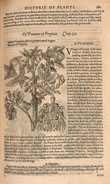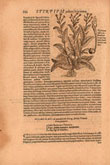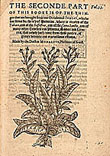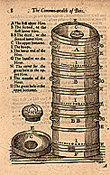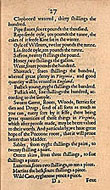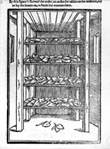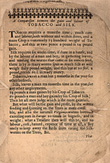Virginia Commodities It became obvious to most, if not all, that no passage to the Indies or cache of mineral wealth would be found in Virginia. In 1616, John Chamberlain reported, "I heare not of any other riches or matter of worth, but only some quantities of sassafras, tobacco, pitch, and clap-board." As the Company dispatched ever larger numbers of colonists to Virginia, investors continued to emphasize the importance of a diversified economic base. The commercial advantages of various commodities were touted by their supporters, and Company officials—for the most part armchair farmers who had not been to Virginia—sent orders and instructions about growing crops and achieving harvest quotas that were often unrealistic. In fact, all of the suggested crops were ones that the settlers had no previous experience growing or processing in England. Even tobacco, which took center stage so early and completely, required expertise and proper equipment and its cultivation saw several setbacks before being profitably established. An absence of draught animals and repeated cycles of drought added to the difficulties of achieving the Company's aims for profitable returns on their investment in Virginia. |
||
[31] Potatoes This is the first published picture of the white potato (as distinguished from the sweet potato, also native to America), a plant that eventually became a staple of European diets. In 1585 one variety of potato was bought to England by Sir Francis Drake, who had encountered them in his raids on Spanish outposts in the Caribbean–it was on this trip that he stopped at Virginia and brought the Roanoke colonists home. Perhaps this is the origin of Gerard's mistaken notion that the white potato was native to Virginia; on the other hand, it may have been his desire to flatter Queen Elizabeth by introducing this new food plant as a product of her namesake colony. |
||
[32] Tobacco By 1569, tobacco was familiar in English gardens, but it was Spain that supplied the herb in the quantity required to satisfy the demand for recreational smoking in England. In the early imagery and writing about tobacco it is often impossible to tell which of the two American species is being described. Brazil was the origin of Nicotiana tobacum, which by the contact period had spread to the West Indies; Mexico was the origin of rustica, which had spread naturally to areas east of the Mississippi and north along the Atlantic coast. Early English settlers in Virginia considered the rustica too harsh, but the milder Nicotiana tobacum was introduced from the West Indies by John Rolfe in 1612. By 1616, the majority of Virginia plantations were farming tobacco. The Company was not happy about this turn of events and continued to campaign for diversification, but accepted the reality that tobacco cultivation was essential to getting the colony established. It was, however, never supposed to be anything but a temporary solution. |
||
[33] Tobacco Frampton's translation from the Spanish of this work by Nicolas Monardes was the first in the English language to illustrate the tobacco plant, although it is unclear whether the plant pictured is Nicotiana rustica or tobacum. |
||
[34] Bees There are conflicting statements about when European honeybees were first brought to North America, but there is no doubt that escaped domestic bees— called by Native Americans "white man's flies"—spread rapidly ahead of the colonists as they moved west. Without the honeybee, many European crops could not be grown, a fact that confronts our agricultural system today as it copes with the still-mysterious condition known as "colony collapse disorder" that has resulted in abnormally high die-offs of honeybee colonies in the United States. |
||
[35] Sawmills Instead of burning off all the wood as land was cleared for agriculture, sawmills made it possible to recycle trees into useful and exportable products. |
||
[36] Prices Current for Virginia Among the products listed are clapboards at thirty shillings a hundred, honey at two shillings a gallon, and beeswax at four pounds a hundredweight.
|
||
[37] Promotional Map John Farrer and his daughter, Virginia, were actively involved in attempts to develop the American silk industry. Williams's book extols the virtues of Virginia, and the section about the benefits of silk production was most likely supplied by Virginia Farrer. In fact, the map itself (with north to the right) could be considered a tool to encourage emigration aimed at an English audience that probably still recalled the massacre of 1622. Considerable liberty is taken with North American geography to present the continent as manageable and very English. Farrer tips his hat to the old dream of an easy passage to Asia by announcing that a ten days march will take a traveler from the Chesapeake to the Pacific. Sir Francis Drake's New Albion on the California coast emphasizes its nearness and its Englishness. |
||
[38] Indians as Slave Labor? This illustration shows the structure where the silkworms were placed to spin their cocoons. Part of the discussion of Virginia commodities involved who would perform the labor. After the massacre of 1622, enslavement of the Native Americans seemed like a good idea to many Virginia promoters. Bonoeil also tempts his audience with the old dream of a passage to Asia. “they that know no industry, no Arts, no culture, nor no good use of this blessed country heere, but are meere ignorance, sloth, and brutishness, and an unprofitable burthen onely of the earth: such as these … are naturally borne slaves.” [furthermore a] “passage to the South Sea, will, beyond our falls and mountaines, through the continent of Virginia, assuredly be found. |
||
[39] A Perfect Solution This contrast between the efforts of silk and tobacco cultivation is unrealistically weighted in favor of silk. Elsewhere in his book Hartlib suggests that raising silk is a tedious, simple task, a perfect fit for the simple Indian and a perfect way for Native Americans to earn the money to purchase English trade goods. “And also to the good hopes. that the Indians, seeing and finding that there is neither art, skill, or pains in the thing: they will readily set upon it, being by the benefit thereof inable to buy of the English (in way of truck for their silk-bottoms) all those things that they most desire.” |
||
[40] In Hindsight: Lessons Learned Published in the year of his death, John Smith's plan for successful colony-planting in New England was drawn from his experience in Virginia. Lambasting Virginia Company officials in London, who caused needless hardship in Virginia by issuing orders based on dreams and theories rather than experience, Smith recommended a practical approach. First, fishing, the economic base on which New England was to be founded, was far more secure than illusory searches for gold, a passage to Asia, or commitment to a nonessential product like tobacco. Second, creating new societies and fostering initiative could best be accomplished by transferring day-to-day control of the colony to the colonists themselves. "With such tedious letters, directions, and instructions … we did admire how it was possible such wise men could so torment themselves and us with such strange absurdities and impossibilities." |
||
| Exhibition prepared by Susan Danforth, Curator of Maps and Prints, John Carter Brown Library. On view in the Reading Room August to November 2007. |

 |
||||||
|---|---|---|---|---|---|---|
| France and Spain on the North American Coast
|
Stirring up English Interest
|
The Beginning of the Virginia Venture
|
A Second Chance for Jamestown
|
Settlement Encouraged
|
Virginia Commodities
|
|
